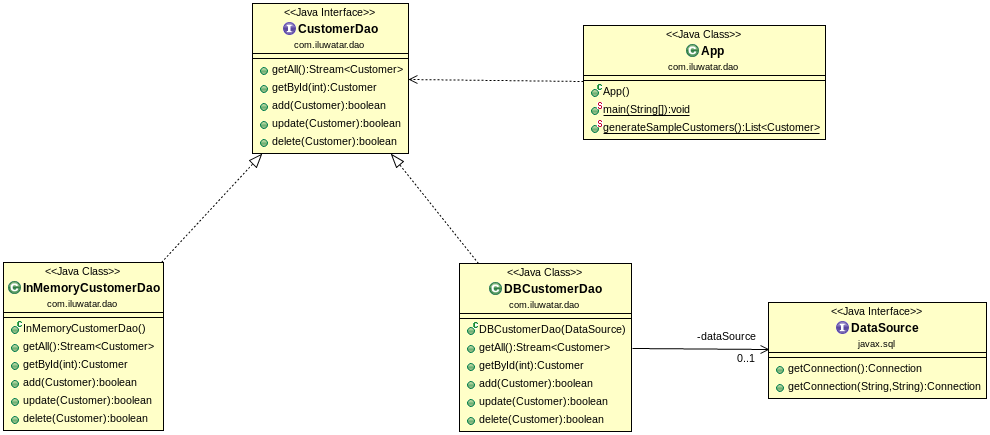Data Access Object
Intent
Object provides an abstract interface to some type of database or other persistence mechanism.
Explanation
Real world example
There's a set of customers that need to be persisted to database. Additionally we need the whole
set of CRUD (create/read/update/delete) operations so we can operate on customers easily.
In plain words
DAO is an interface we provide over the base persistence mechanism.
Wikipedia says
In computer software, a data access object (DAO) is a pattern that provides an abstract interface
to some type of database or other persistence mechanism.
Programmatic Example
Walking through our customers example, here's the basic Customer entity.
public class Customer {
private int id;
private String firstName;
private String lastName;
public Customer(int id, String firstName, String lastName) {
this.id = id;
this.firstName = firstName;
this.lastName = lastName;
}
// getters and setters ->
...
}
Here's the CustomerDao interface and two different implementations for it. InMemoryCustomerDao
keeps a simple map of customers in memory while DBCustomerDao is the real RDBMS implementation.
public interface CustomerDao {
Stream<Customer> getAll() throws Exception;
Optional<Customer> getById(int id) throws Exception;
boolean add(Customer customer) throws Exception;
boolean update(Customer customer) throws Exception;
boolean delete(Customer customer) throws Exception;
}
public class InMemoryCustomerDao implements CustomerDao {
private final Map<Integer, Customer> idToCustomer = new HashMap<>();
// implement the interface using the map
...
}
@Slf4j
public class DbCustomerDao implements CustomerDao {
private final DataSource dataSource;
public DbCustomerDao(DataSource dataSource) {
this.dataSource = dataSource;
}
// implement the interface using the data source
...
Finally here's how we use our DAO to manage customers.
final var dataSource = createDataSource();
createSchema(dataSource);
final var customerDao = new DbCustomerDao(dataSource);
addCustomers(customerDao);
log.info(ALL_CUSTOMERS);
try (var customerStream = customerDao.getAll()) {
customerStream.forEach((customer) -> log.info(customer.toString()));
}
log.info("customerDao.getCustomerById(2): " + customerDao.getById(2));
final var customer = new Customer(4, "Dan", "Danson");
customerDao.add(customer);
log.info(ALL_CUSTOMERS + customerDao.getAll());
customer.setFirstName("Daniel");
customer.setLastName("Danielson");
customerDao.update(customer);
log.info(ALL_CUSTOMERS);
try (var customerStream = customerDao.getAll()) {
customerStream.forEach((cust) -> log.info(cust.toString()));
}
customerDao.delete(customer);
log.info(ALL_CUSTOMERS + customerDao.getAll());
deleteSchema(dataSource);
The program output:
customerDao.getAllCustomers():
Customer{id=1, firstName='Adam', lastName='Adamson'}
Customer{id=2, firstName='Bob', lastName='Bobson'}
Customer{id=3, firstName='Carl', lastName='Carlson'}
customerDao.getCustomerById(2): Optional[Customer{id=2, firstName='Bob', lastName='Bobson'}]
customerDao.getAllCustomers(): java.util.stream.ReferencePipeline$Head@7cef4e59
customerDao.getAllCustomers():
Customer{id=1, firstName='Adam', lastName='Adamson'}
Customer{id=2, firstName='Bob', lastName='Bobson'}
Customer{id=3, firstName='Carl', lastName='Carlson'}
Customer{id=4, firstName='Daniel', lastName='Danielson'}
customerDao.getAllCustomers(): java.util.stream.ReferencePipeline$Head@2db0f6b2
customerDao.getAllCustomers():
Customer{id=1, firstName='Adam', lastName='Adamson'}
Customer{id=2, firstName='Bob', lastName='Bobson'}
Customer{id=3, firstName='Carl', lastName='Carlson'}
customerDao.getCustomerById(2): Optional[Customer{id=2, firstName='Bob', lastName='Bobson'}]
customerDao.getAllCustomers(): java.util.stream.ReferencePipeline$Head@12c8a2c0
customerDao.getAllCustomers():
Customer{id=1, firstName='Adam', lastName='Adamson'}
Customer{id=2, firstName='Bob', lastName='Bobson'}
Customer{id=3, firstName='Carl', lastName='Carlson'}
Customer{id=4, firstName='Daniel', lastName='Danielson'}
customerDao.getAllCustomers(): java.util.stream.ReferencePipeline$Head@6ec8211c
Class diagram

Applicability
Use the Data Access Object in any of the following situations:
- When you want to consolidate how the data layer is accessed.
- When you want to avoid writing multiple data retrieval/persistence layers.